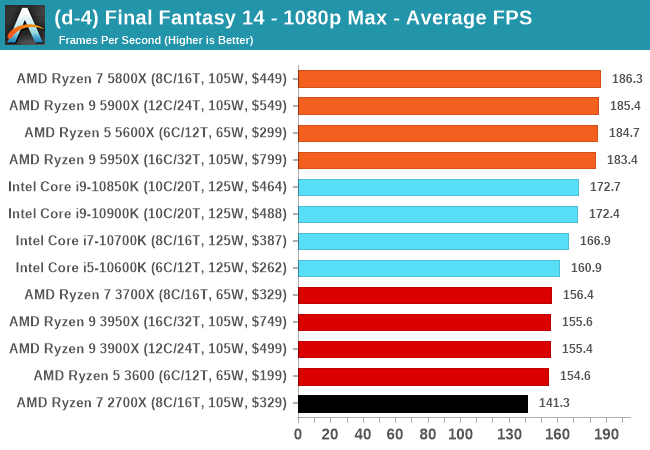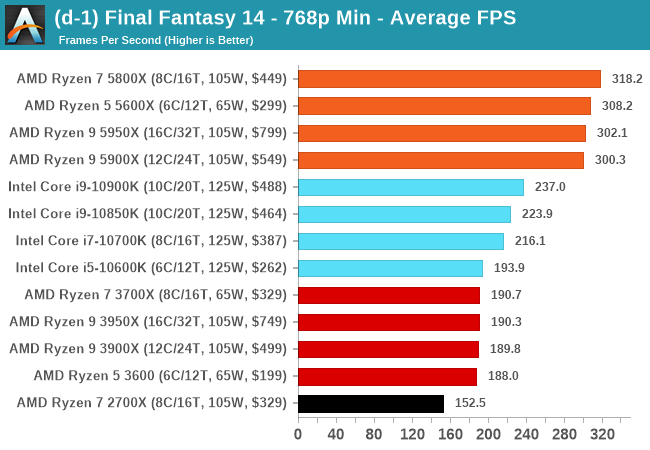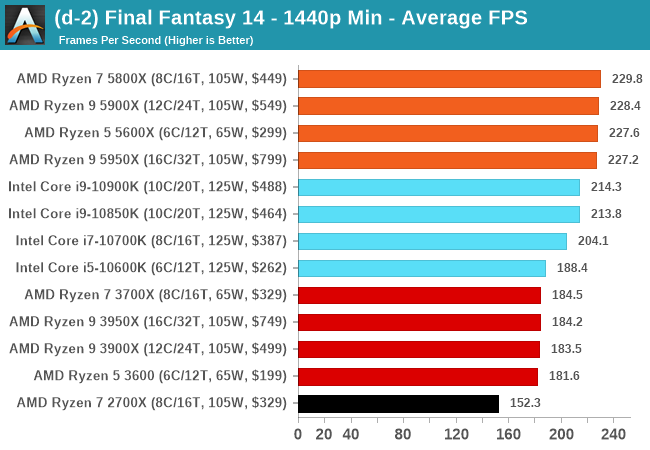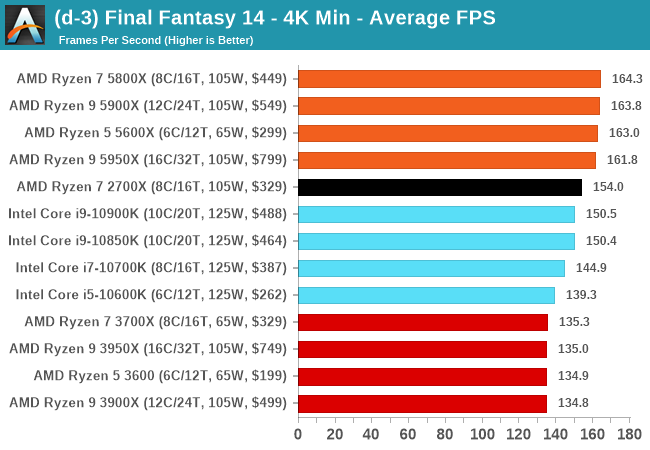AMD Zen 3 Ryzen Deep Dive Review: 5950X, 5900X, 5800X and 5600X Tested
by Dr. Ian Cutress on November 5, 2020 9:01 AM ESTGaming Tests: Final Fantasy XIV
Despite being one number less than Final Fantasy 15, because FF14 is a massively-multiplayer online title, there are always yearly update packages which give the opportunity for graphical updates too. In 2019, FFXIV launched its Shadowbringers expansion, and an official standalone benchmark was released at the same time for users to understand what level of performance they could expect. Much like the FF15 benchmark we’ve been using for a while, this test is a long 7-minute scene of simulated gameplay within the title. There are a number of interesting graphical features, and it certainly looks more like a 2019 title than a 2010 release, which is when FF14 first came out.
With this being a standalone benchmark, we do not have to worry about updates, and the idea for these sort of tests for end-users is to keep the code base consistent. For our testing suite, we are using the following settings:
- 768p Minimum, 1440p Minimum, 4K Minimum, 1080p Maximum
As with the other benchmarks, we do as many runs until 10 minutes per resolution/setting combination has passed, and then take averages. Realistically, because of the length of this test, this equates to two runs per setting.

| AnandTech | Low Resolution Low Quality |
Medium Resolution Low Quality |
High Resolution Low Quality |
Medium Resolution Max Quality |
| Average FPS |  |
 |
 |
 |
All of our benchmark results can also be found in our benchmark engine, Bench.











339 Comments
View All Comments
Spunjji - Sunday, November 8, 2020 - link
True, that combo will rockSpunjji - Sunday, November 8, 2020 - link
Why is 100 watts extra power to get that performance suddenly NBD?CrystalCowboy - Thursday, November 5, 2020 - link
If they would die-shrink that I/O chiplet, they might have room for a third CCD...adt6247 - Thursday, November 5, 2020 - link
Then most motherboards would likely have a hard time with power delivery for 8 additional cores.Also, a the IO die only supports 2 CCDs -- doesn't have the lanes for more. Hence the Threadripper parts with 4 CCDs being NUMA devices -- two CCDs with direct access to RAM, and two without.
lmcd - Thursday, November 5, 2020 - link
Also package size constraints have about just as much to do with pin count. Necessary pin count for supporting 2 more CCDs' worth of bandwidth and power (regardless of board's ability to supply it) pushes AMD entirely out of the ITX motherboard market (barring absolutely insane designs that cost $300-400 for minimum features beyond turning on). And any situation using more than 16 cores needs more bandwidth, so the pin count increase -> no ITX is really a no-go.AntonErtl - Thursday, November 5, 2020 - link
The IO die supports 4 CCXs on the 3900X and 3950X. It seems that a CCD does not get a wider port than a CCX (the ports for Zen3 do not seem particularly wide at 16B/cycle in write width), so it may be possible to connect 4 CCDs to the IO die. Whether that will physically fit, or will be too RAM-bandwidth limited is then the question. But given that Intel cannot even match the 16 cores, there is little competetive pressure to put more cores in AM4.schujj07 - Friday, November 6, 2020 - link
Any single socket Zen 2 device is seen as a single NUMA node. When you talk about 1st & 2nd Gen Threadripper, yes they were seen as 2 or 4 NUMA nodes depending on the number of cores due to how the architecture was made.nandnandnand - Thursday, November 5, 2020 - link
Zen 4 core chiplets will be shrunk to 5nm, on a new AM5 socket that could have larger dimensions. And maybe the I/O chiplet will shrink to 7nm at the same time.I expect 3x 8-core chiplets or 2x 12-core chiplets. A graphics chiplet for all desktop models is possible. If so, maybe 12-core chiplets are the way to go.
smilingcrow - Thursday, November 5, 2020 - link
With only dual channel RAM there will be an issue with performance scaling beyond a certain number of cores.It seems as if the sixteen core part already scales poorly with some workloads, so adding fifty percent more is not great.
Leave that for TR.
phoenix_rizzen - Thursday, November 5, 2020 - link
Yeah, it seems like 1 memory channel for every 8 cores is the sweet spot. At least with DDR4 memory controllers.